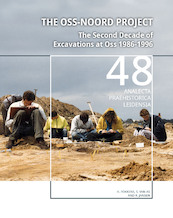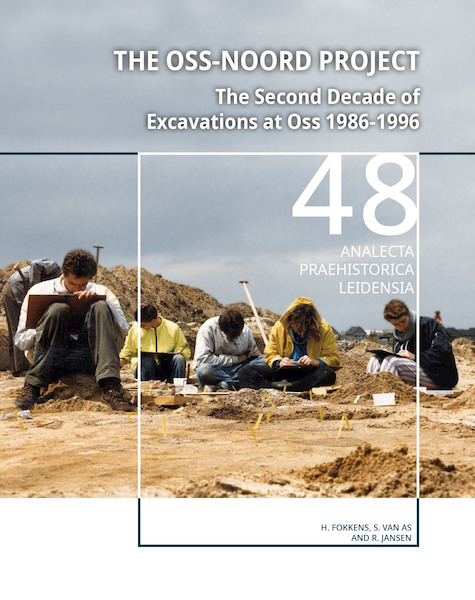| Prijs | € 85,00 |
Niet beschikbaar
Paperback | Oktober 2019 |
Beoordeel dit boek als eerste!Beschrijving
Specificaties
- Auteur
- Harry Fokkens, Stijn Van As, Richard Jansen
- Uitgever
- Sidestone Press
- ISBN
- 9789088907494
- Bindwijze
- Paperback
- Publicatiedatum
- Oktober 2019
- Categorie
- Studieboek
- Taal
- Engelstalig
- Aantal Pagina's
- 400
Beschrijving
After the first decade of large scale settlement research at Oss-Ussen (1974-1984), a second and a third decade followed (1986-2008). The present book is a report on the second decade of settlement excavations, all carried out under supervision of the first author. Started with a focus on the Bronze Age, the project developed into a large scale research of Iron Age and Roman Period settlements and cemeteries over a total area of about 13 ha. The ten campaigns of fieldwork functioned also as the fieldschool of the Faculty of Archaeology of Leiden University, so many of the archaeologists in Dutch Archaeology used their shovels and trowels for the first time in Oss. Due to its narrative style the book is not only meant for professional archaeologists but for everyone interested in Metal Ages and Roman Period in general and the local history of Oss specifically.
The book is divided in two parts. Part 1 describes the results of the excavations in a personal account of how research goals developed in relation to ever changing theoretical and practical circumstances. It presents a synthesis of different study areas with a focus on how the past may have influenced new phases of settlement. In this synthesis also the fieldwork of the first decade and to some extent the third decade of excavations at Oss (Horzak) are taken into account.
Part 2 describes the primary data of the 1986-1995 excavations on which the analyses are based. Due to these mass of data, we have restricted ourselves to a (large) selection of features and structures that yielded information for the synthesis in part 1.
Contents:
Preface
PART 1: Analysis
Chapter 1: Introduction to the project
1.1 Introduction
1.2 The genesis of the Maaskant
1.3 History of the Oss-North Project: continuity and change
1.4 Aims of the project
1.5 Research questions
1.6 Structure of the book: a narrative approach
Chapter 2: Methods and methodology
2.1 Introduction
2.2 Field campaigns
2.3 Staff and students
2.4 Field methods and finds registration
2.5 Documentation and description
Chapter 3: Chronology and typology of structures
3.1 Introduction
3.2 Houses
3.3 Outbuildings and granaries
3.4 Wells and watering holes
3.5 Ditches
3.6 Fences
3.7 Finds
Chapter 4: Excavations in the Mikkeldonk district
4.1 Introduction
4.2 History of reseach
4.3 Episodes of settlement in the Mikkeldonk quarter
Chapter 5: Excavations in the Schalkskamp district (1990 - 1992)
5.1 Short history of research
5.2 Pits and wells of the Early Bronze Age - Middle Bronze Age: the first signs of habitation in the Schalkskamp area
5.3 Late Bronze Age - Early Iron Age
5.4 The Middle Iron Age
5.5 Late Iron Age settlement: abandonment or disaster?
5.6 The transition from the Iron Age to the Early Roman Period
5.7 The Early Roman Period
5.8 The Late Middle Ages re-use the old settlement area
5.9 An anecdote about the early Modern Period
Chapter 6: Excavations in the Mettegeupel district (1993-1995)
6.1 Background
6.2 Diachronic development of the cultural landscape
Chapter 7: Excavations in the Almstein district (1995)
7.1 Introduction
7.2 Three granaries from the Early or Middle Iron Age
7.3 A settlement of the Middle to the Late Iron Age
7.4 The Roman Period
7.5 The Middle Ages and Modern Period
Chapter 8: Vegetation and crops in Oss-North
8.1 Oss-North and the vegetation on the yards of its Bronze, Iron Age and Early Roman Age farms
8.2 The crops of the Oss-North farmers during the Bronze Age and Iron Age
Chapter 9: The animal bones of Mettegeupel, Mikkeldonk and Schalkskamp
9.1 Introduction
9.2 Methods
9.3 Preservation
9.4 General results
9.5 Results per site
9.6 Discussion
Chapter 10: Glass, metal, stone, clay and wooden objects from Oss-Noord
10.1 Introduction
10.2 The La Tène glass jewellery from Oss-Noord
10.3 Metal and metal production remains
10.4 Sling bullets
10.5 Stone and flint objects
10.6 Loom weights and spindle whorls
Chapter 11: Oss-North: the second decade of excavations at Oss; a synthesis
11.1 Objectives
11.2 Settlement dynamics
11.3 Themes of supra-local interest
PART 2: Description
Chapter 12: Introduction to the catalogue
12.1 Introduction
12.2 Structure of the data presentation
12.3 Descriptive elements
12.4 Note on MapInfo as a publication tool
12.5 Note on drawings and technicians
12.6 Note on numbering
12.7 Structure of the catalogue
Chapter 13: Features in the Mikkeldonk quarter
13.1 Introduction
13.2 Houses
13.3 Granaries and outbuildings
13.4 Pits and wells
13.5 Fences, ditches and cart-tracks
13.6 Funerary Structures
Chapter 14: Features in the Schalkskamp quarter
14.1 Introduction
14.2 Houses
14.3 Outbuildings
14.4 Pits and wells
14.5 Ditches and fences
14.6 Funerary structures
Chapter 15: Features in the Mettegeupel quarter
15.1 Introduction
15.2 Houses
15.3 Granaries and outbuildings
15.4 Pits and wells
15.5 Ditches and palisades
15.6 Funerary structures
Chapter 16: Features in the Almstein quarter
16.1 Introduction
16.2 Houses
16.3 Granaries
16.4 Ditches and palisades
Schrijf een recensie
Specificaties
- Auteur
- Harry Fokkens, Stijn Van As, Richard Jansen
- Uitgever
- Sidestone Press
- ISBN
- 9789088907494
- Bindwijze
- Paperback
- Publicatiedatum
- Oktober 2019
- Categorie
- Studieboek
- Taal
- Engelstalig
- Aantal Pagina's
- 400











